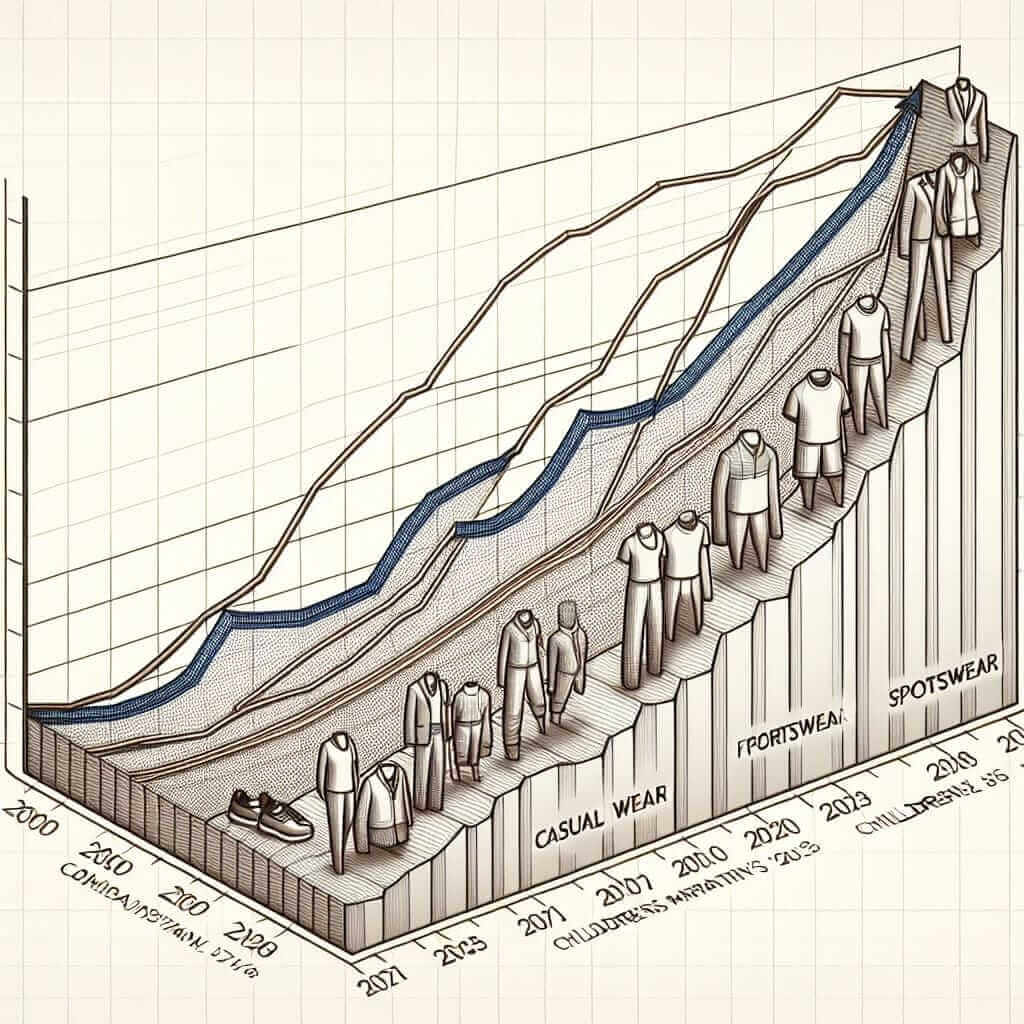In the ever-changing landscape of consumer preferences, the sales of different types of clothing from 2000 to 2023 provide fascinating insights. This topic is a frequent subject in IELTS Writing Task 1 due to its complex yet accessible nature, offering a good mix of data analysis and description, which are crucial skills to develop for the IELTS exam.
Nội dung bài viết
Introduction
When preparing for the IELTS Writing Task 1, analyzing the sales of different types of clothing over a period is a common scenario. By examining trends and variations in sales data, we can enhance our ability to describe complex information succinctly and accurately.
Example Task 1 Prompt
The chart below shows the sales of different types of clothing (formal wear, casual wear, sportswear, and children’s wear) from 2000 to 2023. Summarize the information by selecting and reporting the main features, and make comparisons where relevant.
Choosing a Task to Create Sample Writing
Let’s use the following hypothetical data for our writing task:
Sales Data (in millions of units)
| Year | Formal Wear | Casual Wear | Sportswear | Children’s Wear |
|---|---|---|---|---|
| 2000 | 20 | 35 | 25 | 30 |
| 2005 | 25 | 40 | 35 | 28 |
| 2010 | 30 | 50 | 40 | 35 |
| 2015 | 28 | 60 | 55 | 40 |
| 2020 | 25 | 65 | 60 | 50 |
| 2023 | 27 | 70 | 65 | 55 |

Analyzing the Task
Key Features:
-
Overall Trends:
- Steady increase in all types of clothing sales over the period.
- Casual wear consistently shows the highest sales.
- Formal wear shows the least growth compared to other categories.
-
Notable Points:
- Significant rise in sportswear sales from 2010 to 2015.
- Children’s wear shows the most consistent growth trajectory.
- A slight dip in formal wear sales between 2010 and 2020.
Sample Writing Task
Model Answer
The chart illustrates the sales of four categories of clothing: formal wear, casual wear, sportswear, and children’s wear, from 2000 to 2023.
Overall, the sales of all categories increased steadily over the given period. Casual wear consistently had the highest sales, peaking at 70 million units in 2023. In contrast, formal wear showed the least growth, with sales increasing only moderately during the same period.
In detail, the sales of casual wear rose from 35 million units in 2000 to 70 million units in 2023, nearly doubling over 23 years. Sportswear followed a similar pattern, with its sales increasing from 25 million units in 2000 to 65 million units in 2023. This category witnessed the most dramatic rise between 2010 and 2015, jumping from 40 to 55 million units.
Children’s wear also experienced growth, though at a more steady pace compared to the other categories. Starting at 30 million units in 2000, it reached 55 million units by 2023. Notably, children’s wear sales overtook those of formal wear around 2020.
Formal wear, while experiencing occasional fluctuations, had a slower growth rate compared to other categories. Sales started at 20 million units in 2000, reached a peak of 30 million units in 2010, dipped slightly in 2020, but ended at 27 million units in 2023.
In conclusion, while the sale of all types of clothing increased over the period from 2000 to 2023, casual wear maintained the highest sales, and formal wear saw the least growth.
(Word count: 251)
Key Notes on Writing
Vocabulary and Grammar Tips:
-
Trends and Pattern Descriptions:
- Phrases such as “steady increase,” “remained high,” “showed a slight dip,” and “overtook” are crucial for describing trends.
-
Comparative Language:
- Use comparative structures like “more than,” “less than,” and “compared to” to highlight differences effectively.
-
Passive Voice:
- Passive constructs can create a formal tone, e.g., “sales were recorded.”
Complex Sentences:
- Combining multiple pieces of data in one sentence without losing clarity is important.
Example: “While casual wear sales nearly doubled from 35 million units in 2000 to 70 million units in 2023, formal wear saw only a moderate increase, peaking at 30 million units in 2010 before stabilizing at 27 million units by 2023.”
Vocabulary Highlights:
- Consistent (adj): kənˈsɪstənt | Steady in pattern or growth.
- Fluctuation (n): ˌflʌk.tʃuˈeɪ.ʃən | Irregular rising and falling in number or amount.
- Dramatic (adj): drəˈmæt.ɪk | Significant in size, extent, or degree.
- Peak (n): piːk | The highest point or value.
- Trajectory (n): trəˈdʒek.tɚ.i | The path followed by a trend or development.
Conclusion
Understanding how to analyze and describe data like the sales of different types of clothing (2000-2023) is essential for achieving high scores in the IELTS Writing Task 1. By focusing on trends, utilizing comparative language, and structuring sentences efficiently, students can clearly and effectively communicate their analysis. Remember to apply this approach to similar tasks to gain proficiency and confidence in the exam.